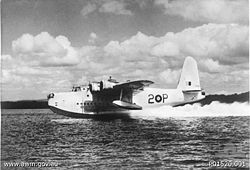No. 461 Squadron RAAF
| No. 461 Squadron RAAF | ||
|---|---|---|
 A No. 461 Squadron Sunderland Mark V landing at Pembroke Dock, Wales in 1944 | ||
| Active | 25 April 1942 – 4 June 1945 | |
| Disbanded | 4 June 1945 | |
| Country | ||
| Allegiance | ||
| Branch | ||
| Role | Maritime patrol | |
| Part of | No. 19 Group RAF, Coastal Command[1] | |
| Motto(s) | "They shall not pass unseen"[2][3] | |
| Battle honours |
| |
| Insignia | ||
| Squadron Badge heraldry | A demi-shark couped, pierced by a harpoon Patrol Short Sunderland | |
No. 461 Squadron was a
Squadron history
No. 461 Squadron was formed at
During 1943, No. 461 Squadron mainly conducted daylight anti-submarine patrols over the Bay of Biscay, having moved to a new base at Pembroke Dock in April 1943. These patrols exposed the squadron's aircraft to frequent attacks by German fighters. The Sunderland aircraft were fitted with a heavy defensive armament, however, and were often successful in beating off fighter attacks. During 1943, the squadron sank a total of three U-boats. By May 1943, No. 461 Squadron was fully equipped with the more advanced Mark III Sunderland. This aircraft allowed the Squadron to operate at night. Equipped with these improved aircraft the squadron continued to fly anti-submarine patrols over the Atlantic, including patrols in support of the Allied landing in Normandy. The squadron sank three U-boats during 1944.[7]
Following the liberation of France the numbers of German U-boats in the Atlantic declined and No. 461 Squadron made few contacts with the enemy between October 1944 and the end of the war; between September and October 1944 a detachment from the squadron operated over Norwegian waters from a base in the Shetland Islands. No. 461 Squadron was disbanded at Pembroke Dock on 4 June 1945. The squadron lost 20 Sunderlands to enemy action and accidents. A total of 86 squadron members of all nationalities were killed on operations, including 64 Australians. The squadron was awarded six battle honours for its wartime service.[7]
U-boats destroyed
During the war No. 461 destroyed a total of six German U-boats. These were:[7][8]
- U-332 (1 May 1943)
- U-461 (30 July 1943)
- U-106 (2 August 1943)
- U-571 (28 January 1944)
- U-385 (10 August 1944)
- U-270 (13 August 1944)
Aircraft operated
| From | To | Aircraft | Version |
|---|---|---|---|
| April 1942 | May 1943 | Short Sunderland | Mk.II |
| August 1942 | June 1945 | Short Sunderland | Mk.III |
| February 1945 | June 1945 | Short Sunderland | Mk.V |
Squadron bases
| From | To | Base | Remark |
|---|---|---|---|
| 25 April 1942 | 31 August 1942 | RAF Mount Batten, Devon | |
| 31 August 1942 | 21 April 1943 | RAF Hamworthy Junction, (Poole Harbour) Dorset | |
| 21 April 1943 | 20 June 1945 | RAF Pembroke Dock, Pembrokeshire, Wales | Det. at Shetland Islands, Scotland , 28 September 1944 – 29 October 1944
|
Commanding officers
| From | To | Name |
|---|---|---|
| May 1942 | August 1942 | Wing Commander N.A.R. Halliday
|
| August 1942 | January 1943 | Wing Commander R.C.O. Lovelock |
| January 1943 | February 1944 | Wing Commander D.L.G. Douglas, DFC |
| February 1944 | February 1945 | Wing Commander J.M. Hampshire, DFC |
| February 1945 | June 1945 | Wing Commander R.R. Oldham |
References
Notes
- ^ Delve 1994, p. 73.
- ^ a b Rawlings 1982, p. 223.
- ^ a b c d Halley 1988, p. 481.
- ^ Bowyer & Rawlings 1979, p. 102.
- ^ Flintham & Thomas 2003, p. 114.
- ^ Eather 1995, p. 119.
- ^ a b c d e "No. 461 Squadron". Second World War, 1939–45 units. Australian War Memorial. Archived from the original on 24 February 2018. Retrieved 14 November 2014.
- ^ Eather 1995, pp. 119–120.
- ^ a b c Rawlings 1982, p. 224.
- ^ a b Jefford 2001, p. 95.
Bibliography
- Bowyer, Michael J.F.; Rawlings, John D.R. (1979). Squadron Codes, 1937–56. Cambridge, UK: Patrick Stephens. ISBN 0-85059-364-6.
- Delve, Ken (1994). The Source Book of the RAF. Shrewsbury, Shropshire, UK: Airlife Publishing. ISBN 1-85310-451-5.
- Eather, Steve (1995). Flying Squadrons of the Australian Defence Force. Weston Creek, Australian Capital Territory: Aerospace Publications. ISBN 1-875671-15-3.
- Flintham, Vic; Thomas, Andrew (2003). Combat Codes: A Full Explanation and Listing of British, Commonwealth and Allied Air Force Unit Codes Since 1938. Shrewsbury, Shropshire, UK: Airlife Publishing. ISBN 1-84037-281-8.
- Halley, James J. (1988). The Squadrons of the Royal Air Force & Commonwealth, 1918–1988. Tonbridge, Kent, UK: Air-Britain (Historians). ISBN 0-85130-164-9.
- Jefford, C.G. (2001) [1988]. RAF Squadrons: A Comprehensive Record of the Movement and Equipment of All RAF Squadrons and Their Antecedents Since 1912 (2nd ed.). Shropshire, UK: Airlife Publishing. ISBN 1-85310-053-6.
- Rawlings, John D.R. (1982). Coastal, Support and Special Squadrons of the RAF and their Aircraft. London: Jane's Publishing Company. ISBN 0-7106-0187-5.
Further reading
- Ashworth, Norman (1994). The Anzac Squadron: A History of No 461 Squadron Royal Australian Air Force, 1942–1945. Carlisle, Western Australia: Hesperian Press. ISBN 0-85905-198-6.
- RAAF Historical Section (1995). Units of the Royal Australian Air Force: A Concise History. Volume 4 – Maritime and Transport Units. Canberra: Australian Government Publishing Service. ISBN 9780644427968.
- OCLC 9069916.
